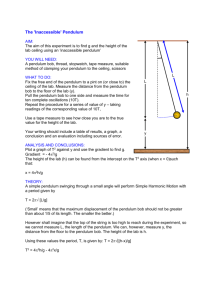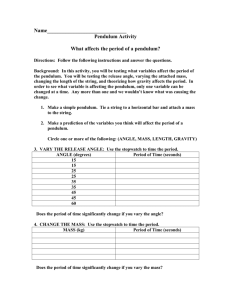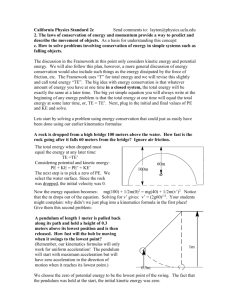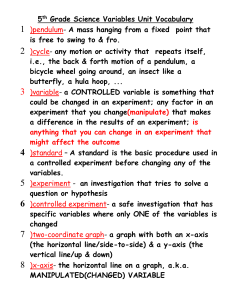PHYS 1030L Simple Pendulum
advertisement
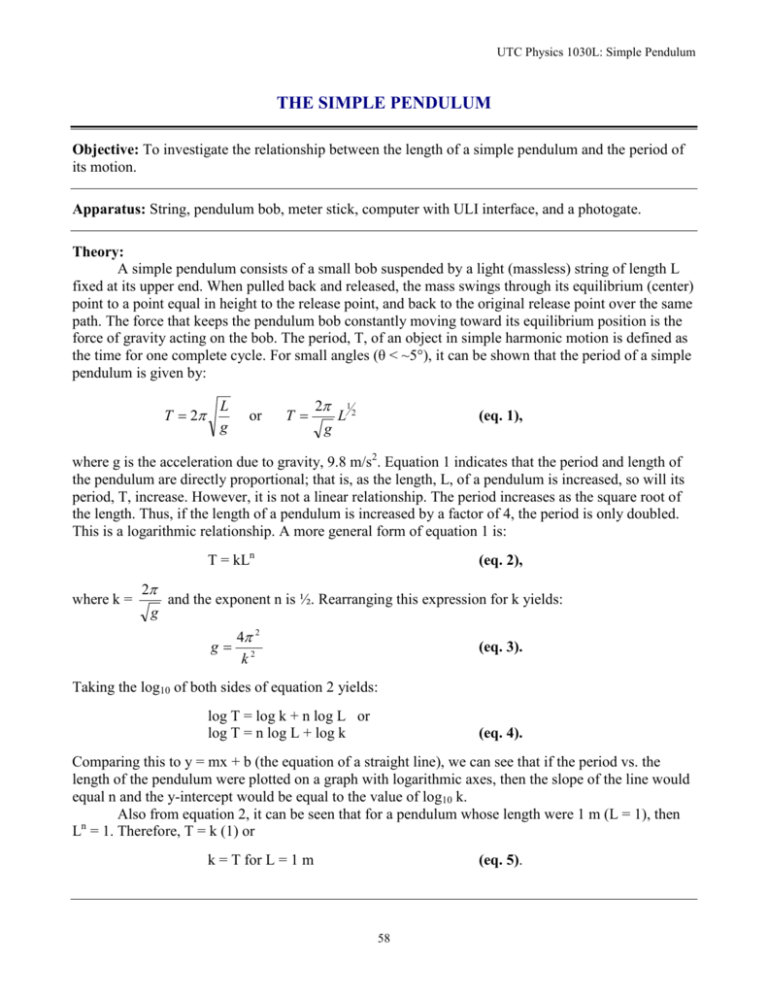
UTC Physics 1030L: Simple Pendulum THE SIMPLE PENDULUM Objective: To investigate the relationship between the length of a simple pendulum and the period of its motion. Apparatus: String, pendulum bob, meter stick, computer with ULI interface, and a photogate. Theory: A simple pendulum consists of a small bob suspended by a light (massless) string of length L fixed at its upper end. When pulled back and released, the mass swings through its equilibrium (center) point to a point equal in height to the release point, and back to the original release point over the same path. The force that keeps the pendulum bob constantly moving toward its equilibrium position is the force of gravity acting on the bob. The period, T, of an object in simple harmonic motion is defined as the time for one complete cycle. For small angles (θ < ~5°), it can be shown that the period of a simple pendulum is given by: T 2 L g or T 2 g L 1 2 (eq. 1), where g is the acceleration due to gravity, 9.8 m/s2. Equation 1 indicates that the period and length of the pendulum are directly proportional; that is, as the length, L, of a pendulum is increased, so will its period, T, increase. However, it is not a linear relationship. The period increases as the square root of the length. Thus, if the length of a pendulum is increased by a factor of 4, the period is only doubled. This is a logarithmic relationship. A more general form of equation 1 is: T = kLn where k = 2 g (eq. 2), and the exponent n is ½. Rearranging this expression for k yields: g 4 2 k2 (eq. 3). Taking the log10 of both sides of equation 2 yields: log T = log k + n log L or log T = n log L + log k (eq. 4). Comparing this to y = mx + b (the equation of a straight line), we can see that if the period vs. the length of the pendulum were plotted on a graph with logarithmic axes, then the slope of the line would equal n and the y-intercept would be equal to the value of log10 k. Also from equation 2, it can be seen that for a pendulum whose length were 1 m (L = 1), then Ln = 1. Therefore, T = k (1) or k = T for L = 1 m (eq. 5). 58 UTC Physics 1030L: Simple Pendulum Procedure: Experimental Set-up: 1. Make sure that the ULI Interface is connected to the computer. Make sure the photogate is connected to the DIG-1 port on the ULI Interface. 2. Construction of the pendulum: Thread a string through the hole at the center of the metal ball. Hang the pendulum on the holder as shown in Figure 1. Caution: The string must be held tightly between the small piece of metal and the main holder. 3. Adjust the length of the pendulum so that L = 1.30 m. This should be the distance between the bottom of the holder and the center of the bob where the string is threaded (as shown in Figure 1). The length of the pendulum is the distance from the position of the fixed point of the string to the position of the center of mass of the bob. Lab Table Figure 1. Experimental Set-up 4. Place the photogate so that the bob will swing through it and move it up or down until the center of the mass of the bob is at the center of the detector, as shown in Figure 2. Make sure that a point close to the center of the bob (but not the hole through the center) passes directly in front of the detection element of the photogate. This ensures that the detection element will be entirely blocked when the bob passes through its equilibrium position. Figure 2. 59 UTC Physics 1030L: Simple Pendulum 5. Make sure that the ULI interface is on. On the computer, open the program LoggerPro 3. Open the “Physics with Vernier” folder and select the file “14 Pendulum Periods”. Test that the photogate is operational by blocking the sensor with your hand, which should change the GateState to “blocked” from “unblocked” at the bottom of the screen. Data collection and analysis: 1. Pull the bob back and away from vertical equilibrium position to a position about 3 cm from equilibrium. Click “collect” to initialize data collection. If prompted, click “YES” to erase any previous data. Data collection will begin automatically. 2. Release the bob. The computer should be recording the time interval between each passing of the bob through the photogate in order to calculate the period, or time for one complete revolution. The reading of the period of vibration should be displayed to 3 decimal places. 3. The period (in seconds), is displayed as the pendulum swings. Just after the pendulum is started, the bob is not yet in simple harmonic motion, so the value of the period will change. After the reading stabilizes (this could be anywhere from 10-50 readings), stop collecting data (click on “Stop”) and record the value on your data sheet. 4. Adjust the length of the pendulum to 1.10, 0.90, 0.70, 0.50, and 0.30 m and repeat steps 1-3 above. 5. Calculate values for log L and log T for your data points to complete the table on your data sheet. 6. Construct a graph of the period vs. the length of a pendulum with axes that are linear in scale. You may do so in Excel 2007 if desired. a. Type in the data table from your data sheet with the columns in the same order. (Note when making a graph, Excel always chooses the leftmost highlighted column as the x-axis). b. Highlight the first two columns of data (length and period). From the Insert tab, choose scatter and the option for “Scatter with only Markers”. c. When the graph is selected, the Chart tools appear. Under the Design tab, click on Move Chart, and select “New Sheet”. d. Add an appropriate chart title and axis titles under the Layout menu of the Chart Tools. 60 UTC Physics 1030L: Simple Pendulum e. Under the Chart Tools Layout tab, and the Analysis tools, click Trendline and “More Trendline Options”. Select the Power regression type and check the options for Display Equation on chart and Display Rsquared value on Chart. Print the graph. f. The equation of the regression should now appear on the chart. Compare this with equation 2 to locate your value for n and k and record them on your data sheet. 7. Construct a graph of log T vs. log L with axes that are linear in scale. a. Highlight the data in columns C and D on your data sheet. From the Insert tab, choose scatter and the option for “Scatter with only Markers”. Move the chart to a new sheet, and add a chart title and axis titles. b. Fit the data with a linear trendline, displaying the equation and R-squared value on the chart. c. Compare the equation of regression with equation 4 to find the slope and y-intercept, which correspond to n and log k, respectively. Calculate k by raising 10 to the value of the yintercept. Record the appropriate values on your data sheet and print the graph. 8. Construct a graph of the period vs. the length of a pendulum using the logarithmically-scaled graph paper provided with your data sheet. a. Plot the data: your x-data points should be the lengths of the pendulum (in meters), and the corresponding y-values are the period (in seconds) of the last reading. Note that the half-way point between each division corresponds to about 3, not 5. b. Draw the best fit line through the data. Although this should visually appear to be linear, the axes are scaled logarithmically, so it actually represents a fit of the form in equation 2. c. Find the value of n, which represents the exponent on the value of length in the equation that relates it to the period of the pendulum (equation 2). As shown in equation 4, the value of n should be the linear fit to your data as plotted on logarithmic graph paper. To find the slope, choose two points on the line whose coordinates are (x1, y1) and (x2, y2). These need not be actual data points, but need to be two points that are on the fit line and that have conveniently-read coordinates. The slope, n, is found by: slope log y 2 log y1 log x 2 log x 1 d. Find the value of the constant k in equation 2, which would be the period, T, if the length of the pendulum were 1.00 m. From your log-log graph of T vs. L, read T at L = 1.00 m. 9. Use equation 3 to find the value of g, the acceleration due to gravity, from the value of k determined from any of your graphs. Show the calculation on your data sheet. 61 UTC Physics 1030L: Simple Pendulum Lab Report Format: Your lab report for this experiment should contain: 1. Pre-lab (objective, theory, sketch of the experimental set up, and procedure). 2. Neatly written copy of your experimental data sheet. 3. Sample calculations: Show your calculations for the value of n from the logarithmic plot, the value of g and a percent difference for g, k, and n in your sample calculations section of the report. 4. Graphs: Include all three graphs. Make sure each has a title, appropriately-labeled axes with units, and a best-fit line to the data with an equation (in the form of y = kxn or y = mx + b). 5. Results: Report your results for the values of n, k, and g (in complete sentences). Make sure all values are properly rounded and have the correct number of significant digits. Is the value of n what you expected it to be from the theory? – compare it with a percent difference calculation. Is the value of g reasonable compared to theory? – compare it with a percent difference calculation. What is the most likely source of uncertainty in the experiment that would lead to the percent differences? 6. Conclusions and Discussion: Answer the following questions in paragraph format. 1. Compare the results obtained from each of the three graphs. Do the different methods of graphing produce different results? 2. Where is the y-intercept on your logarithmic graph, and what is the value of k at the yintercept? Explain whether this agrees with the value of k reported from estimating the period at a length of 1 m? 3. To what does the x-intercept correspond on graph 2 (log T vs. log L)? What is the length of the pendulum needed to produce a period of 1 second? 4. We have previously calculated a value for g by the acceleration due to gravity experiment. Which method, this, or the previous lab, gave you the most accurate value for g? Explain reasons why this may be the case. 62



